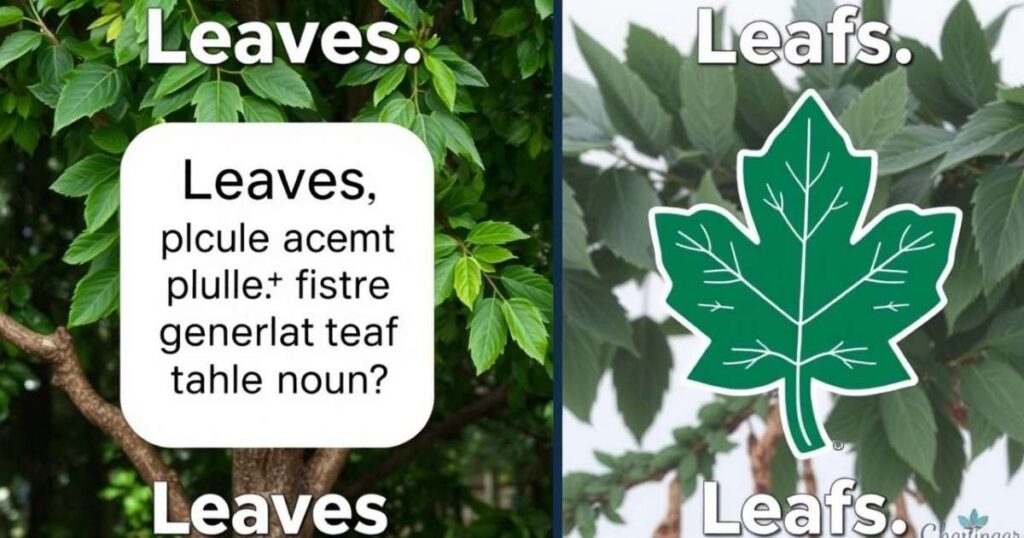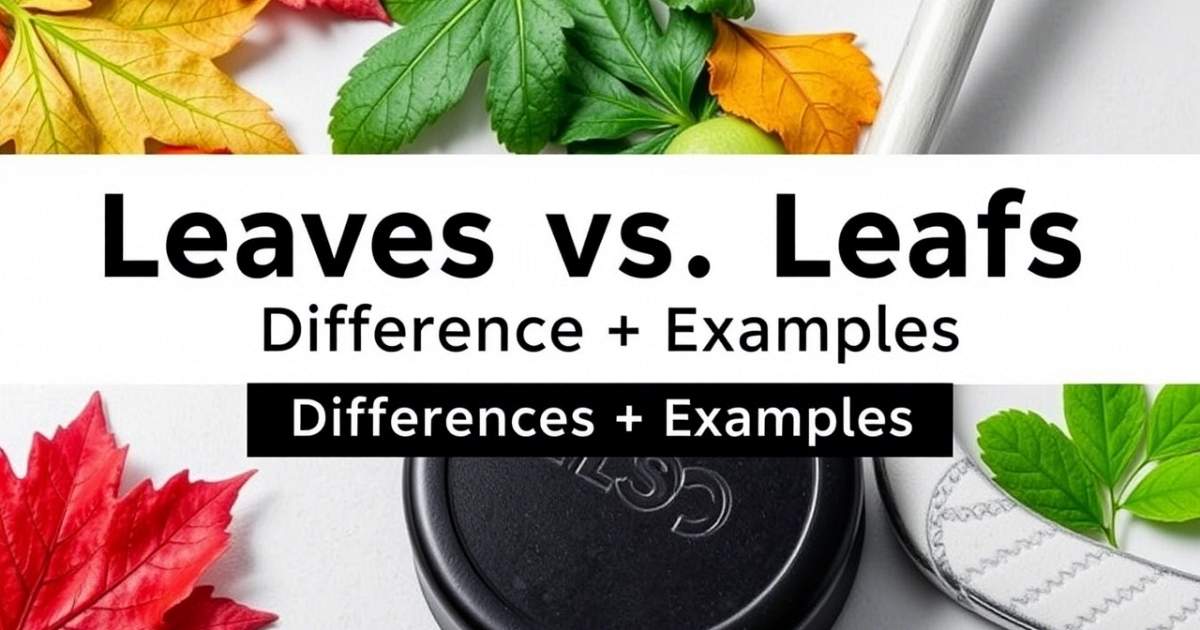Leaves vs. Leafs, a simple mix-up or a real head-scratcher? You’ve probably seen both words, but do they mean the same thing? Not quite! The difference between leaves and leafs is all about context. In nature, “leaves” is correct, trees shed leaves, not “leafs.” But in hockey, things change. The Toronto Maple Leafs break the grammar rule, making “leafs” famous in sports. And that’s where the leafs v leaves debate begins!
So, what’s the real leaves vs leafs meaning? It’s all about usage. In English, “leaves” is the proper plural of “leaf.” But in sports, “leafs” sticks as a team name. The difference between leaf and leaves is simple, one is singular, one is plural. “Leafs” isn’t wrong, just special! Next time you see it, ask yourself: Are we talking about nature or hockey?
Understanding Pluralization in English
Pluralization in English can be tricky, especially with irregular words. Most nouns follow a simple rule, just add “s” or “es.” But some words change completely, like “child” becoming “children” or “mouse” turning into “mice.” These exceptions make English unique and sometimes confusing.
One common mix-up is Leaves vs. Leafs. Normally, the plural of “leaf” is “leaves.” Trees, plants, and nature-related topics always use “leaves.” But in sports, especially hockey, “leafs” appears in team names like the Toronto Maple Leafs. This is where grammar rules bend for branding.
The difference between leaves and leafs is all about context. If you’re talking about nature, “leaves” is correct. If you’re referring to the hockey team, “leafs” is the right choice. The leafs v leaves debate exists because language evolves with culture.
Even in construction, terms vary. For example, “door leaves” is correct when talking about doors. The difference between leaf and leaves depends on the subject.
Understanding pluralization helps with clear communication. Whether discussing Leaves vs. Leafs, other irregular plurals, or grammar exceptions, knowing the rules makes writing easier!
The Plural and Singular Usage
Singular and plural words help us express quantity clearly. In English, most words follow simple rules to change from singular to plural. However, some words have irregular forms that can be confusing. One such example is Leaves vs. Leafs, where the pluralization depends on context.
Most nouns add “-s” to form plurals. For example, “car” becomes “cars,” and “book” becomes “books.” If a word ends in “-ch,” “-sh,” “-x,” or “-s,” we usually add “-es,” like “box” to “boxes.” These rules cover most cases, but there are exceptions.
Some nouns change spelling in the plural form. Words ending in “f” or “fe” often become “ves,” such as “wolf” to “wolves” and “leaf” to “leaves.” This is why “leaves” is the correct plural for the natural meaning of “leaf.”
Irregular nouns don’t follow normal rules. Words like “child” to “children” or “foot” to “feet” require memorization. Some words, like “sheep,” don’t change at all. Understanding these exceptions is important for good grammar.
Learning singular and plural forms helps with clear communication. Whether talking about nature, objects, or special names, knowing how words change improves writing and speaking skills.
Common Rules for Pluralization in English
Pluralizing nouns in English follows basic patterns, but there are exceptions. Understanding these rules helps in writing and speaking correctly. Most words simply add “-s” to form the plural, like “cat” to “cats” and “house” to “houses.”
Words ending in “-ch,” “-sh,” “-x,” “-s,” or “-z” usually take “-es” instead of just “-s.” For example, “box” becomes “boxes,” and “church” becomes “churches.” This rule helps with pronunciation and makes plural words easier to say.
For nouns ending in “-y,” the plural depends on the letter before it. If there’s a vowel before “-y,” just add “-s” (e.g., “key” to “keys”). If there’s a consonant, change “y” to “i” and add “-es” (e.g., “baby” to “babies”).
Words ending in “-f” or “-fe” often change to “-ves.” Examples include “leaf” to “leaves” and “wolf” to “wolves.” However, some words, like “roof,” just add “-s.” This is why Leaves vs. Leafs is a common question for learners.
Memorizing these rules makes English easier. Some words don’t follow them, like “child” to “children” or “tooth” to “teeth.” Learning these patterns improves communication skills.
Leaves vs. Leafs: Grammar vs. Proper Nouns

English can be tricky, and Leaves vs. Leafs is a great example. The confusion comes from grammar rules and how proper nouns work.
In standard grammar, the plural of “leaf” is “leaves.” This follows the rule where words ending in “-f” or “-fe” often change to “-ves” in the plural. So, trees have leaves, and autumn is known for falling leaves.
However, “Leafs” is not a standard plural. It appears as a proper noun, like in the Toronto Maple Leafs hockey team. The team kept “Leafs” instead of “Leaves” for consistency in their name.
This shows how language can bend when it comes to names. Proper nouns don’t always follow standard grammar rules. That’s why “Leafs” works in hockey but not in nature.
Understanding the Leaves vs. Leafs difference helps with clear communication. Whether talking about trees or sports, context matters in choosing the right word.
The Difference Between Leaves and Leafs
English has many confusing word pairs, and Leaves vs. Leafs is one of them. While they look similar, they have different meanings and uses.
“Leaves” is the correct plural of “leaf.” It refers to the green structures on trees and plants. In autumn, the leaves change color and fall to the ground.
“Leafs,” on the other hand, is not a standard plural. It appears mainly in the name of the Toronto Maple Leafs, a famous hockey team. The team name doesn’t follow normal grammar rules.
The key difference between leaves and leafs is that “leaves” follows standard grammar, while “leafs” is used only in proper names. If you’re talking about nature, always use “leaves.”
Knowing the Leaves vs. Leafs distinction helps with proper word usage. Whether writing about trees or hockey, choosing the right word keeps communication clear.
Here are 20 examples of pluralizing nouns that end in “F” or “FE”:
Words That Change “F” or “FE” to “VES”:
- Leaf → Leaves
- Wolf → Wolves
- Knife → Knives
- Life → Lives
- Loaf → Loaves
- Calf → Calves
- Thief → Thieves
- Elf → Elves
- Self → Selves
- Shelf → Shelves
Words That Simply Add “S”:
- Roof → Roofs
- Cliff → Cliffs
- Chef → Chefs
- Proof → Proofs
- Belief → Beliefs
- Gulf → Gulfs
- Puff → Puffs
- Reef → Reefs
- Dwarf → Dwarfs (Though “dwarves” is also accepted)
- Scarf → Scarfs (Some people also use “scarves”)
The Leaves vs. Leafs rule follows this pattern, where “leaves” follows the “ves” rule, while “leafs” is an exception in proper nouns like the Toronto Maple Leafs.
Singular and Plural Confusions in Everyday Speech

English can be tricky when it comes to singular and plural forms. Many words don’t follow standard rules, leading to common mistakes in daily conversations. Some words change entirely in their plural form, while others remain the same. This can cause confusion, especially for learners.
For example, the word “child” becomes “children,” not “childs.” Similarly, “man” turns into “men,” and “woman” becomes “women.” These irregular forms can be difficult to remember. In contrast, some words stay the same, like “deer,” “sheep,” and “fish,” which don’t add an “s” in the plural form.
The confusion also extends to borrowed words from other languages. For instance, “cactus” becomes “cacti,” and “fungus” turns into “fungi.” Many people mistakenly add “s” instead, saying “cactuses” or “funguses.” While these forms are now accepted in informal speech, they aren’t the traditional plurals.
Another common issue is with sports teams and proper nouns, such as “Leaves vs. Leafs.” In nature, the correct plural is “leaves,” but in hockey, “Maple Leafs” is used instead of “Maple Leaves.” Understanding these differences helps improve communication and grammar skills.
Mastering singular and plural forms takes time, but paying attention to patterns and exceptions can make learning easier. Recognizing these irregularities in everyday speech ensures clearer and more accurate conversations.
- “The leaves rustled gently as the autumn wind swept through the trees.”
- “She carefully pressed the colorful leaves into her scrapbook.”
- “The gardener removed the dried leaves to help new ones grow.”
- “Golden leaves covered the ground, marking the arrival of fall.”
- “The children gathered leaves for their school art project.”
- “He studied the leaves under a microscope to observe their structure.”
- “The maple leaves turned a deep red as the season changed.”
- “A gust of wind sent the leaves swirling into the air.”
- “The old book had fragile leaves of paper that crinkled with age.”
- “After the rain, the leaves glistened with tiny droplets of water.”
- “During the hike, they admired the different shapes of leaves along the trail.”
- “The leaves provided much-needed shade on the hot summer afternoon.”
- “In winter, most trees lose their leaves, standing bare against the sky.”
- “She brewed tea using freshly picked mint leaves from her garden.”
- “The leaves on the oak tree remained green longer than the others.”
- “Sunlight filtered through the leaves, casting dappled shadows on the ground.”
- “The sound of dry leaves crunching underfoot filled the quiet forest.”
- “Leaves danced in the air before settling on the river’s surface.”
- “He sketched the intricate patterns on the leaves for his art project.”
- “The leaves of the aloe plant have a soothing gel inside them.”
How Context Affects Plural Word Usage
The meaning of a word can change depending on context, especially when dealing with plural forms. Some words follow standard rules, while others have exceptions. Understanding these differences helps in proper communication.
Take Leaves vs. Leafs as an example. “Leaves” is the correct plural form of “leaf” when referring to trees. However, in proper names like the Toronto Maple Leafs, “leafs” is used instead.
Some words change completely in plural form. “Child” becomes “children,” and “mouse” turns into “mice.” These irregular cases must be learned individually.
Certain words remain the same in singular and plural forms. “Deer” and “sheep” do not change, even when referring to multiple animals.
Context matters in everyday speech. “Glasses” can mean eyewear, but “glass” refers to a drinking cup. Learning plural rules in context improves clarity and avoids confusion.
Examples:
- “The leaves turned golden in autumn.”
- “The Maple Leafs won the game.”
- “The oxen pulled the cart through the field.”
- “She saw a group of deer in the forest.”
- “The children played in the park all day.”
- “His glasses were on the table.”
- “The glass shattered on the floor.”
- “Many fish swam in the lake.”
- “The geese flew south for winter.”
- “Several cacti grew in the desert.”
- “The wolves howled under the full moon.”
- “The moose wandered near the river.”
- “The men and women gathered for the meeting.”
- “The scissors were too sharp.”
- “The data was carefully analyzed.”
- “She bought new jeans from the store.”
- “The aircraft landed safely.”
- “His pants were too long.”
- “The bacteria spread quickly.”
- “The series of books became very popular.”
- “The dice rolled across the table.”
- “The sheep grazed in the meadow.”
- “The alumni returned for the reunion.”
- “The news spread fast.”
- “The headquarters was in the city center.”
Related Guide:
Ride the Tide [Definition + Examples]
Pluralization in Sports Team Names and Branding
Sports teams often break traditional pluralization rules. Some teams use standard plural forms, while others adopt unique names for branding purposes. These variations make team names memorable and distinctive.
A great example is Leaves vs. Leafs. The plural of “leaf” is “leaves,” but the Toronto Maple Leafs use “leafs” instead. This happens because team names often prioritize branding over grammar.
Some teams use singular nouns, like the Miami Heat or the Orlando Magic. These names work because they represent concepts rather than countable items. Similarly, teams like the Utah Jazz and Oklahoma City Thunder follow this pattern.
Other teams stick to traditional pluralization, such as the Chicago Bulls or the New York Yankees. These names use the standard plural form of their root words.
Understanding pluralization in sports branding shows how language adapts. Team names prioritize identity, recognition, and marketing over strict grammatical rules.
- The Toronto Maple Leafs have a unique spelling in their team name.
- The New York Yankees are one of the most famous baseball teams.
- The Chicago Bulls dominate the NBA with their powerful team performance.
- The Miami Heat represents a city known for its fiery passion for basketball.
- The Orlando Magic name evokes an enchanting and mystical vibe.
- The Utah Jazz holds on to its singular name, even though it refers to music.
- The Oklahoma City Thunder represents the powerful storm system.
- The Dallas Cowboys are a football team with a strong cultural legacy.
- The New England Patriots represent American history and national pride.
- The Detroit Lions are fierce competitors in the NFL.
- The Los Angeles Lakers became iconic through basketball excellence.
- The San Antonio Spurs name reflects Western heritage and toughness.
- The Washington Nationals follow traditional pluralization rules.
- The Denver Broncos use plural naming to show their team strength.
- The Atlanta Hawks have soaring ambitions in the NBA.
- The Boston Celtics carry the proud tradition of Irish-American culture.
- The Carolina Panthers dominate the NFL with their fierce defense.
- The Pittsburgh Steelers represent the steel industry legacy of the city.
- The Cleveland Browns have a historically loyal fan base.
- The Seattle Seahawks are known for their energetic and dynamic performances.
- The Minnesota Vikings honor the Nordic warrior tradition.
- The San Francisco Giants embrace a name that conveys power.
- The Kansas City Chiefs take inspiration from Native American leaders.
- The Green Bay Packers use a plural form to represent their team unity.
- The Los Angeles Dodgers use the plural for their baseball team legacy.
Why Some Words Have Multiple Plural Forms

Some words in English have multiple plural forms due to irregularities in their grammatical structure, historical usage, or differences in regional preferences. These variations can stem from the word’s origin or the context in which it’s used. For example, words borrowed from other languages may retain their original plural forms. Others may simply evolve in usage over time.
English has many irregular nouns, and some words allow two forms for their plural, with each version having a slightly different nuance or use. In many cases, one form may be more commonly accepted, while the other is often used in specific contexts or regions.
Here are 20 examples of words with multiple plural forms:
- Cactus – Cacti, Cactuses
- Focus – Foci, Focuses
- Crisis – Crises, Crisises
- Appendix – Appendices, Appendixes
- Index – Indices, Indexes
- Alumnus – Alumni, Alumnuses
- Criterion – Criteria, Criterions
- Medium – Media, Mediums
- Thesis – Theses, Thesises
- Bacterium – Bacteria, Bacteriums
- Datum – Data, Datums
- Formula – Formulae, Formulas
- Focus – Foci, Focuses
- Kid – Kids, Kidders
- Memento – Mementos, Memento
- Memo – Memos, Memora
- Cuckoo – Cuckoos, Cuckoo
- Bison – Bison, Bisones
- Die – Dice, Dies
- Fish – Fish, Fishes
FAQ’s
Which is correct, leaves or leafs?
“Leaves” is correct for nature, while “leafs” is used in names like the Toronto Maple Leafs. The Leaves vs. Leafs debate depends on context.
Why are leaves not leaves?
In hockey, “leafs” is a proper noun for the Toronto Maple Leafs. The Leaves vs. Leafs rule changes when used as a team name.
Is leafs a word or not?
“Leafs” isn’t a standard plural for “leaf” but exists in names. The Leaves vs. Leafs confusion happens because of exceptions like sports teams.
Is it door leafs or leaves?
“Door leaves” is correct in construction. The Leaves vs. Leafs difference shows “leaves” is used for both doors and trees, unlike in hockey.
Is it tea leaves or Leafs?
“Tea leaves” is correct for dried tea. The Leaves vs. Leafs debate doesn’t apply here since “leafs” only appears in names, not everyday language.
Conclusion
Understanding Leaves vs. Leafs is easy when you know the rules. In nature, “leaves” is the correct plural of “leaf.” Trees and plants have leaves, not “leaves.” But in hockey, things are different. The Toronto Maple Leafs use “leafs” in their team name. This creates the leafs v leaves debate. The difference between leaves and leaves depends on context. One is for nature, the other for sports.
The leafs vs leaves meaning is simple. “Leaves” is the proper plural, while “leafs” is a special name. The difference between leaf and leaves matters in writing and speaking. Using the right word makes your meaning clear. If you’re talking about trees, use “leaves.” If you’re talking about hockey, “leafs” is correct. So next time you see “leafs,” check the context. Now you know why the Leaves vs. Leafs debate exists!

Zion Blaze is a dedicated administrator with 5 years of experience in managing operations, optimizing workflows, and ensuring efficiency. Skilled in leadership, problem-solving, and team coordination.

